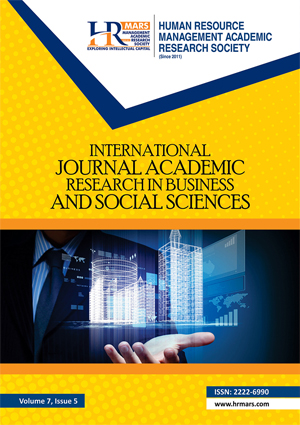
ISSN: 2222-6990
Open access
Urbanization significantly impacts land use patterns and environmental sustainability. This study uses Geographically Weighted Regression (GWR) to assess urban land use change in a metropolitan area, employing spatially explicit data and GWR modeling techniques to identify local factors influencing land use dynamics. The GWR 4.0 software was utilized for model evaluation and analysis processing, while ArcGIS 10.8 was used for spatial analysis and mapping. Goodness-of-fit criteria were applied to assess the GWR model's performance. The analysis showed improvements in model fit: the Akaike Information Criterion (AICc) decreased from 1509.10 to 1297.31, the Bayesian Information Criterion (BIC) dropped from 1525.77 to 721.24, and the R-squared increased from 0.01 to 0.23, indicating a better fit for localized measurements. The findings reveal that proximity to Mass Rapid Transit (MRT) stations is a significant factor influencing land use changes in the study area. This highlights the need for localized planning strategies that address urban challenges and support sustainable development.
Brunsdon, C., Fotheringham, A. S., & Charlton, M. E. (1996). Geographically weighted regression: A method for exploring spatial nonstationarity. Geographical Analysis, 28(4), 281-298.
Chen, J., Li, X., & Zhao, X. (2016). Spatial analysis of urban land use change in Shanghai: A geographically weighted regression approach. Journal of Urban Planning and Development, 142(3), 04016008.
Department of Statistics Malaysia. (2020). Population and housing census of Malaysia 2020. Putrajaya: DOSM.
Ding, L. (2022). Exploring the linkage between land use type and stream water quality of an estuarine island applying GWR model: A case study of Chongming, Shanghai. Journal of Geoscience and Environment Protection.
Fotheringham, A. S., Brunsdon, C., & Charlton, M. E. (2002). Geographically weighted regression: The analysis of spatially varying relationships. John Wiley & Sons.
Hu, Y., Wang, X., & Song, Y. (2019). Spatial analysis of urban land use change with geographically weighted regression. Journal of Environmental Management, 240, 59-66.
Hurvich, C. M., Simonoff, J. S., & Tsai, C.-L. (1998). Smoothing parameter selection in nonparametric regression using an improved Akaike information criterion. Journal of the Royal Statistical Society Series B, 60, 271-293. https://doi.org/10.1111/1467-9868.00125
Lim, M. H., & Nor, N. M. (2020). Assessing urban land use change in Kuala Lumpur using geographically weighted regression. Applied Spatial Analysis and Policy, 13(3), 721-741.
Loh, C., & Hamid, Z. (2020). Urbanization and infrastructure development in Cheras, Kuala Lumpur. Malaysian Journal of Urban Planning, 8(2), 45-58.
Man, N. I., & Majid, N. A. (2024). Urban landscape changes and land use patterns: The impact of Mass Rapid Transit (MRT) system construction in the context of development in the Klang Valley between 2010 and 2020. International Journal of Academic Research in Business and Social Sciences, 242-251.
Man, N. I., Majid, N. A., & Dziauddin, M. F. (2024a). Corak guna tanah: Impak pembangunan sistem Mass Rapid Transit (MRT) di Lembah Klang daripada tahun 2010 dan tahun 2020. 2nd International Conference on Geography, Environment and Sustainability 2024, 47-48.
Man, N. I., Majid, N. A., & Rainis, R. (2024b). Unveiling the spatial imprint of Mass Rapid Transit (MRT) stations: An analysis of population density shifts in Klang Valley using the 2020 census data. International Journal of Academic Research in Business and Social Sciences, 1770-1784.
Man, N. I., Majid, N. A., Rainis, R., & Ahmed, M. F. (2024c). Mass Rapid Transit (MRT) and urban transformation: A case study of Kuala Lumpur's Damansara. International Journal of Academic Research in Business and Social Sciences, 1758-1769.
Miller, J. A., & Wentz, E. A. (2003). The effects of variable resolution on data analysis: A case study using GWR and urban data. Computers, Environment and Urban Systems, 27(5), 461-477.
Páez, A., & Wheeler, D. (2009). Geographically weighted regression. Elsevier.
Pasculli, A., Palermi, S., Sarra, A., Piacentini, T., & Miccadei, E. (2014). A modelling methodology for the analysis of radon potential based on environmental geology and geographically weighted regression. Environmental Modelling & Software, 54, 165-181. https://doi.org/10.1016/j.envsoft.2014.01.006
Prasarana Malaysia Berhad. (2020). MRT Sungai Buloh-Kajang line: A comprehensive overview. Kuala Lumpur: Prasarana.
Samsudin, S., & Malek, J. A. (2018). Urban expansion and its impact on the environment: A case study of Kuala Lumpur, Malaysia. Environmental Monitoring and Assessment, 190(3), 169.
Seto, K. C., Guneralp, B., & Hutyra, L. R. (2012). Global forecasts of urban expansion to 2030 and direct impacts on biodiversity and carbon pools. Proceedings of the National Academy of Sciences, 109(40), 16083-16088.
Shen, L., Wu, Y., Lou, Y., & Zhang, X. (2019). Urbanization, economic growth, and carbon dioxide emissions: A panel data analysis of Asian countries. Sustainable Cities and Society, 46, 101425.
Tan, P. H., & Abdul Rahman, M. (2019). Environmental impact of urban development in Cheras: A case study of green space loss and mitigation strategies. Environmental Management Journal, 14(3), 128-140.
Tan, Y., Yap, K. S., & Ng, C. F. (2021). Urban land use change and sustainable development in Kuala Lumpur: A geospatial analysis. Cities, 108, 102976.
Tu, J., & Xia, Z.-G. (2008). Examining spatially varying relationships between land use and water quality using geographically weighted regression I: Model design and evaluation. Science of the Total Environment, 407, 358-378. https://doi.org/10.1016/j.scitotenv.2008.09.031
Tu, Q., & Xia, J. (2008). Impact of transportation infrastructure on urban land use: A geographically weighted regression analysis. Urban Studies, 45(2), 247-267.
UN-Habitat. (2016). World cities report 2016: Urbanization and development – Emerging futures. United Nations Human Settlements Programme.
UN-Habitat. (2022). World cities report 2022: Envisaging the future of cities. United Nations Human Settlements Programme.
Majid, N. A., & Zaki, N. M. (2025). Assessing Urban Land Use Change through Geographical Weighted Regression: Implications for Sustainable Environmental Planning. International Journal of Academic Research in Business and Social Sciences, 15(2), 223–235.
Copyright: © 2025 The Author(s)
Published by HRMARS (www.hrmars.com)
This article is published under the Creative Commons Attribution (CC BY 4.0) license. Anyone may reproduce, distribute, translate and create derivative works of this article (for both commercial and non-commercial purposes), subject to full attribution to the original publication and authors. The full terms of this license may be seen at: http://creativecommons.org/licences/by/4.0/legalcode